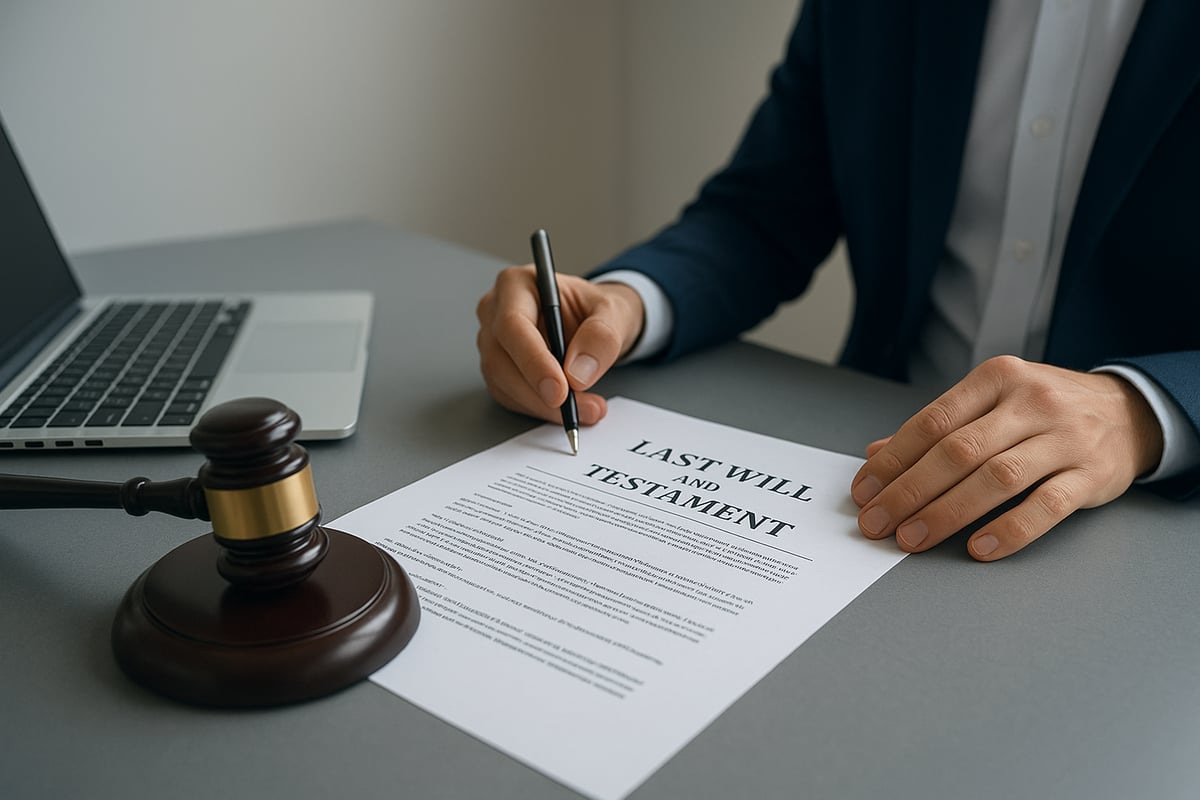Will and Testament Guide: Secure Your Wishes in 2025
Imagine your loved ones left in confusion because your wishes were never clearly stated. In 2025, not having a will and testament can expose your family to unnecessary stress, legal delays, and costly disputes.
This guide provides the latest, expert-backed advice for securing your legacy and protecting those you care about most. Estate planning is more urgent than ever, given new digital solutions and changing laws.
You will learn what a will is, why it matters, how to create one step by step, key legal requirements for 2025, common mistakes to avoid, and the best digital tools for peace of mind.
Understanding Wills and Testaments: What They Are and Why They Matter
A will and testament is more than just a legal document; it is the foundation of your legacy and your family’s future security. Legally, a will and testament is a written declaration in which you specify how your assets, property, and guardianships should be handled after your passing. The terms “will,” “last will,” and “testament” are often used interchangeably, but all refer to this crucial document in estate planning.
A will and testament typically covers the distribution of real estate, personal property, cash, investments, and even digital assets. It can also name guardians for minor children and assign caretakers for pets. Despite its importance, over 60% of Americans do not have a will and testament, according to recent research. For a deeper dive into the basics and benefits, you can explore this comprehensive overview of wills, trusts, and estate planning.

Defining a will
A will and testament provides legal clarity about your wishes, ensuring that your property and responsibilities are managed as you intend. This document appoints an executor to carry out your instructions, names beneficiaries for your belongings, and can specify guardians for dependents or pets.
Key features that must be included:
- List of all major assets
- Instructions for asset distribution
- Names of guardians for minors or pets
- Appointment of an executor
The absence of a will and testament leaves decisions to the courts. This situation can lead to delays and confusion for your loved ones. More than 60% of Americans lack a will and testament, underscoring the need for greater awareness and action.
The Importance of Having a Will in 2025
Without a will and testament, you die “intestate,” which means state laws decide how your estate is divided. This often results in disputes among family members, increased legal costs, and potentially lengthy delays in asset distribution. For parents, not having a will and testament means a judge will decide who cares for your children. Pet owners also risk leaving their animals in uncertain situations.
Real-life cases show that families can face months or even years of legal battles when there is no clear will and testament. As of 2025, some states are beginning to recognize digital wills, making it easier to ensure your wishes are documented and accessible. The peace of mind that comes from a will and testament is invaluable for everyone involved.
Key Differences: Will vs. Living Will vs. Living Trust
While a will and testament is essential for distributing your property after death, it is important to understand how it compares to other legal documents. A living will is used for medical decisions if you become incapacitated, while a living trust allows you to transfer assets without probate.
|
Document |
Purpose |
When Used |
Avoids Probate? |
|---|---|---|---|
|
Will and Testament |
Distributes assets, appoints guardians |
After death |
No |
|
Living Will |
Specifies medical treatment wishes |
Incapacity (while alive) |
N/A |
|
Living Trust |
Holds and manages assets for heirs |
During life and after |
Yes |
Each document serves a unique role. For example, a will is ideal for naming guardians, while a living trust benefits those seeking to bypass probate. Choosing the right combination ensures your wishes are fully protected.
Essential Elements to Look for
Creating a valid will is more than a formality—it is a crucial step in safeguarding your legacy and ensuring your wishes are honored. Every effective will and testament has several core components that must be addressed with care and clarity.

Core Components Every Will Must Include
A comprehensive will and testament requires several key elements. Start with the testator’s personal information, including full legal name and address, to avoid identification issues. Next, clearly appoint an executor who will oversee the administration of your estate.
List beneficiaries by full names and relationships. Specify how each asset—such as real estate, financial accounts, personal property, and digital assets—should be distributed. For parents and pet owners, naming guardians or caretakers is essential to ensure loved ones are protected.
Legal requirements demand that the testator is of sound mind and at least 18 years old. The document must be signed and properly witnessed to be valid. Use clear, precise language to prevent disputes. For example, a specific bequest clause might read:
I give my grandmother’s wedding ring to my daughter, Jane Smith.
A residuary clause covers remaining assets:
I give all the rest, residue, and remainder of my estate to my spouse, John Smith.
Storing your will securely is vital. Digital family vaults, such as those described in Digital family vaults for wills, can help safeguard documents and ensure your loved ones can access your wishes when needed.
Choosing an Executor and Guardians
Selecting an executor is a significant decision in any will and testament. The executor is responsible for managing your estate, settling debts, and distributing assets according to your instructions. Choose someone trustworthy, organized, and willing to serve. It is wise to name a backup executor in case your primary choice is unavailable.
When appointing guardians for minor children or pets, consider both legal eligibility and compatibility with your values. Communicate openly with your chosen guardians to confirm their willingness. Disputes can arise when expectations are unclear or if multiple parties believe they are best suited for the role.
To prevent conflicts, outline your reasoning in the will and testament, and discuss your choices with family members in advance. Documenting your intentions in detail reduces confusion and helps ensure a smooth transition for those you care about most.
Types of Wills: Which One Fits Your Needs?
There are several types of wills to consider when drafting your will and testament. The most common is the simple will, suitable for straightforward estates. Testamentary trusts are included within a will and testament to provide ongoing management for beneficiaries, often used for minors or individuals with special needs.
Joint and mutual wills are typically used by couples who wish to make reciprocal arrangements. Holographic wills are handwritten by the testator and may not require witnesses, but their validity depends on state laws. Oral wills, though rare and only recognized in limited situations, are spoken instructions given near death.
Here is a quick comparison:
|
Will Type |
Best For |
Witnesses Required |
Probate Avoidance |
|---|---|---|---|
|
Simple Will |
Most individuals |
Yes |
No |
|
Testamentary Trust |
Parents, special needs |
Yes |
No |
|
Joint/Mutual Will |
Married couples |
Yes |
No |
|
Holographic Will |
Emergencies, quick wishes |
Varies |
No |
|
Oral Will |
Last resort, rare cases |
Varies |
No |
Selecting the right will and testament type depends on your family, assets, and long-term goals. Consult legal professionals for complex needs or blended families to ensure your document is both valid and effective.
Step-by-Step Guide: How to Write a Will and Testament in 2025
Creating a will and testament in 2025 is a straightforward process when you follow a clear, step-by-step approach. This guide walks you through each essential stage, helping you secure your wishes and protect your legacy with confidence.

Step 1: Gather and Organize Your Assets
Begin your will and testament by taking stock of everything you own. List all real estate, bank accounts, investments, vehicles, jewelry, family heirlooms, and digital assets such as online accounts and cryptocurrencies.
Keeping an up-to-date inventory is vital. Use a spreadsheet or a dedicated estate planning template to track each item’s value and location. Remember, some assets cannot be governed by your will and testament, such as life insurance policies or retirement accounts with named beneficiaries. These pass directly to the named individuals, regardless of what your will states.
Organize paperwork and digital records for easy access. This step ensures your executor can efficiently locate and distribute your assets according to your will and testament.
Step 2: Decide on Beneficiaries and Bequests
Next, determine who will receive your property and assets. Beneficiaries can include family members, friends, charities, or organizations. Use your will and testament to specify both specific bequests (e.g., “my grandfather’s watch to my niece”) and residuary bequests (everything else remaining).
For blended families or estranged relatives, clarity is crucial. Ambiguous language in your will and testament leads to confusion and disputes. Consider the needs of stepchildren or loved ones who might otherwise be overlooked.
Here is an example of clear bequest language:
I bequeath my primary residence at 123 Main Street to my son, John Doe. All remaining assets are to be divided equally among my children.
Review your choices regularly to ensure your will reflects current relationships and priorities.
Step 3: Appoint an Executor and Guardians
Selecting an executor is a key part of your will. This trusted individual will manage your estate, pay debts, and distribute assets. Choose someone organized, trustworthy, and willing to serve. It is wise to name a backup executor in case your first choice is unable or unwilling to act.
If you have minor children or pets, appoint a guardian in your will. Make sure you discuss this responsibility with your chosen guardian before naming them.
To avoid future disputes, communicate your decisions clearly with all involved parties. This transparency reduces the risk of confusion or legal challenges surrounding your will.
Step 4: Drafting Your Will
There are several ways to draft your will and testament: using a do-it-yourself template, online will platforms, or hiring a legal professional. Each method has its pros and cons, summarized in the table below:
|
Method |
Pros |
Cons |
|---|---|---|
|
DIY Template |
Affordable, quick |
Risk of errors, not state-specific |
|
Online Platform |
Guided process, some legal review |
May lack complex options |
|
Legal Professional |
Custom, state-compliant |
Higher cost |
Regardless of your method, accuracy and clarity are essential. Double-check names, asset details, and instructions. Review your draft regularly, especially after major life changes. Your will should always reflect your current wishes.
Step 5: Signing and Witnessing Your Will
Proper execution is critical to ensure your will is legally valid. In most states, you must sign your will in the presence of at least two witnesses, who are not beneficiaries. Some states allow notarization or digital signatures, and in 2025, more jurisdictions are recognizing electronic wills and remote witnessing.
Avoid common mistakes such as missing signatures or using witnesses who are also beneficiaries, as these can invalidate your will and testament. For a detailed explanation of this process, see the Execution of a will explained.
Stay informed about local legal changes, especially regarding e-wills and online witnessing platforms. A properly executed will and testament stands up to legal scrutiny and ensures your wishes are honored.
Step 6: Safe Storage and Accessibility
Once your will is complete, store it in a secure location. Options include a fireproof home safe, your attorney’s office, or a digital family vault. Inform your executor and key family members where to find your will and testament.
Avoid hiding it in obscure places, as this can cause delays or even loss of your original document. Digital storage solutions offer secure, encrypted access and can automate document delivery when needed.
Regularly review and update your storage arrangements to guarantee your will is accessible when required.
Legal Requirements and Updates for Wills in 2025
Creating a valid will requires careful attention to updated legal standards. In 2025, both traditional and digital changes impact how your wishes are recognized.

Age, Capacity, and Formalities
To create a legally binding will and testament, you must meet core requirements. The testator must be at least 18 years old, possess sound mind, and act voluntarily.
Wills can be written or, in some jurisdictions, oral or handwritten (holographic). Typed wills are most common, while holographic wills are valid in select states if entirely in your handwriting. Most states require two witnesses who are not beneficiaries, and some now accept digital signatures. These formalities ensure your will and testament is recognized in court.
State and Country-Specific Considerations
Local laws significantly affect your will and testament. For example, Texas requires two witnesses for validity, while California allows digital wills under certain conditions. Some states now recognize e-wills and remote witnessing, reflecting new technology and shifting legal standards.
Failing to comply with your state’s rules can lead to will contests or probate delays. According to the 2025 Estate Planning Report by Trust & Will, recent updates are changing how Americans approach estate planning, so review your state’s requirements regularly.
Revocation, Updates, and Codicils
A will and testament is not static. You may revoke it by physically destroying the document, creating a new will, or through a codicil—an amendment to your original will.
Major life events, such as marriage, divorce, children, or significant asset changes, should prompt an update. Experts recommend reviewing your will and testament annually to ensure it reflects your current wishes. Codicils must meet the same formalities as an original will to be valid.
International Wills and Cross-Border Issues
If you own property in multiple countries or reside abroad, your will and testament faces additional challenges. International wills must comply with the Hague Convention on International Wills for global recognition.
Cross-border estate planning can involve unique tax rules, language requirements, and local formalities. To ensure your will and testament is valid worldwide, consult with legal professionals familiar with international estate law.
Common Mistakes and How to Avoid Them
Mistakes in preparing a will and testament are surprisingly common and can have lasting consequences for your loved ones. Many individuals overlook crucial details, leaving their estate vulnerable to disputes or delays. According to Caring.com's 2025 Wills and Estate Planning Study, over half of Americans still lack a valid will, often due to misconceptions or procrastination. This gap highlights the importance of understanding and avoiding common errors when drafting your will and testament.
Frequent Pitfalls in Will Creation
One of the most frequent mistakes in preparing a will and testament is using vague or unclear language, which can lead to confusion over asset distribution. Missing signatures or improper witnessing are also common errors that may cause a court to invalidate your will and testament. Failing to update your will and testament after significant life changes, like marriage, divorce, or the birth of a child, is another pitfall. Notably, DIY wills without legal review can overlook legal requirements or local laws, risking unintended results. Famous cases, such as Prince and Aretha Franklin, show how costly disputes can arise from unclear or incomplete wills.
Overlooked Assets and Digital Estate Planning
Many people forget to include digital assets in their will and testament, such as online accounts, cryptocurrencies, or cloud-stored photos. This oversight can prevent heirs from accessing valuable or sentimental property. With 75 percent of Americans holding digital assets, but most wills omitting them, the risk of incomplete estate planning is substantial, as highlighted by Estate Planning Statistics 2025 by Gitnux. A comprehensive digital estate checklist should cover social media, email, bank accounts, and digital wallets to ensure nothing is left behind in your will and testament.
Preventing Will Contests and Disputes
To minimize the risk of challenges to your will and testament, communicate your wishes openly with your family and beneficiaries. Including a no-contest clause can discourage disputes, while ensuring proper witnessing and documentation helps validate your intent. Medical records that demonstrate your mental capacity at the time of signing can further protect your will and testament from being contested. Clear instructions and transparency are essential for maintaining family harmony.
When to Seek Professional Help
Certain situations call for expert guidance when drafting a will and testament. Complex estates, blended families, business ownership, or international assets often require legal expertise to address unique challenges. Even if you use an online template, a legal review can catch errors or omissions that might otherwise go unnoticed. Qualified estate attorneys can ensure your will and testament complies with all legal requirements and reflects your true wishes, providing peace of mind for you and your loved ones.
The Probate Process and What Happens After Death
When someone passes away, the process of carrying out their will and testament begins. Probate is the legal procedure that ensures the deceased’s wishes are honored and assets are distributed correctly. Understanding this process is essential for anyone preparing a will and testament, as it affects how quickly and smoothly your loved ones receive their inheritance.
Overview of Probate and Estate Administration
Probate validates a will and testament, giving the executor legal authority to manage the deceased’s estate. The process typically begins when the executor files the will with the local court. The court then reviews the will and testament to confirm its authenticity and appoints the executor if all requirements are met.
During probate, the executor collects and values assets, pays outstanding debts or taxes, and distributes remaining property according to the will and testament. If there is no valid will, state law determines how assets are divided, which can complicate matters for families.
The steps of probate include:
- Submitting the will and testament to the probate court
- Appointing an executor
- Inventorying estate assets
- Paying debts and taxes
- Distributing assets to beneficiaries
This process ensures the legal transfer of assets and provides a clear path for estate settlement.
Timeline and Costs of Probate
The probate process for a will and testament can take anywhere from six months to over a year, depending on estate complexity and possible disputes. Delays often result from unclear instructions, creditor claims, or court backlogs.
Probate costs typically range from 2% to 7% of the estate’s total value. These expenses include court fees, executor compensation, legal fees, and costs for appraisals or accounting services. Larger or more complex estates, or those with contested wills, can incur higher costs and lengthy delays.
Factors affecting probate duration and expense include:
- Size and complexity of the estate
- Number of beneficiaries
- Presence of disputes or will contests
- Local court procedures
Careful planning of your will and testament can reduce both the time and money required for probate.
Avoiding Probate: Strategies and Considerations
Many people aim to minimize the probate process for their will and testament to save time and costs for their heirs. Certain legal tools can help bypass probate entirely or streamline the process. These include living trusts, joint property ownership, and payable-on-death accounts.
A living trust allows assets to transfer directly to beneficiaries without court involvement. Jointly-owned property passes automatically to the surviving owner, while designated beneficiaries on accounts receive funds directly. However, some assets must still pass through probate if not properly titled or included in a trust.
For a deeper look at how probate works and strategies to avoid it, see this Probate sale and estate planning guide. These methods offer peace of mind that your will and testament will be executed efficiently.
Executor’s Duties and Responsibilities
The executor named in your will and testament holds a critical role. They must manage estate assets, settle debts, file taxes, and ensure that all distributions follow your instructions. The executor is responsible for communicating with beneficiaries and keeping accurate records throughout the process.
Key executor duties include:
- Locating and securing assets
- Notifying creditors and paying valid claims
- Filing necessary tax returns
- Distributing assets according to the will and testament
Choosing a capable and trustworthy executor ensures your estate is handled professionally and your wishes are fulfilled.
As you’ve seen, securing your wishes with a clear will and proper estate planning is one of the most important gifts you can leave your loved ones. In today’s digital world, organizing and protecting your documents is essential for true peace of mind. With IronClad Family’s secure digital vault, you can safely store your will and vital information, ensuring your legacy is honored and accessible when it matters most. Take the first step toward safeguarding your family’s future—explore the benefits and Start 14 Day Free Trial today.

Sahar Lester
Sahar Lester is the Founder and CEO of IronClad Family, a company dedicated to helping families and businesses safeguard their most valuable assets through secure digital vaults. With a master’s degree in Security Technologies from the University of Minnesota and experience spanning cybersecurity, leadership, and international commerce, Sahar bridges the gap between innovation and protection. She also serves as an adjunct professor at Metropolitan State University, mentoring the next generation of cybersecurity professionals.



